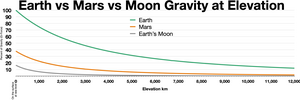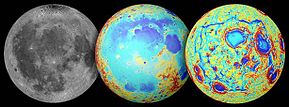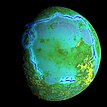
Orbital mechanics or astrodynamics is the application of ballistics and celestial mechanics to the practical problems concerning the motion of rockets, satellites, and other spacecraft. The motion of these objects is usually calculated from Newton's laws of motion and the law of universal gravitation. Orbital mechanics is a core discipline within space-mission design and control.
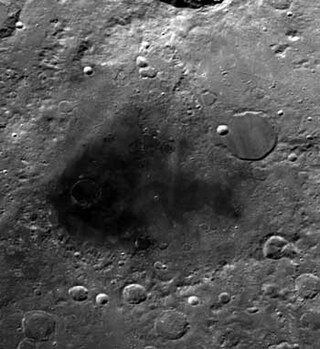
Mare Humboldtianum is a lunar mare located just to the east of Mare Frigoris, in the center of Humboldtianum basin. It is located along the northeastern limb of the Moon, and continues on to the far side. Due to its location, the visibility of this feature can be affected by libration, and on occasion it can be hidden from view from Earth.
Geopotential is the potential of the Earth's gravity field. For convenience it is often defined as the negative of the potential energy per unit mass, so that the gravity vector is obtained as the gradient of the geopotential, without the negation. In addition to the actual potential, a theoretical normal potential and their difference, the disturbing potential, can also be defined.
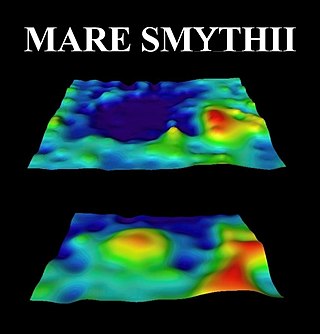
In astronomy, astrophysics and geophysics, a mass concentration is a region of a planet's or moon's crust that contains a large positive gravity anomaly. In general, the word "mascon" can be used as a noun to refer to an excess distribution of mass on or beneath the surface of an astronomical body, such as is found around Hawaii on Earth. However, this term is most often used to describe a geologic structure that has a positive gravitational anomaly associated with a feature that might otherwise have been expected to have a negative anomaly, such as the "mascon basins" on the Moon.

In astrodynamics or celestial mechanics, an elliptic orbit or elliptical orbit is a Kepler orbit with an eccentricity of less than 1; this includes the special case of a circular orbit, with eccentricity equal to 0. In a stricter sense, it is a Kepler orbit with the eccentricity greater than 0 and less than 1. In a wider sense, it is a Kepler orbit with negative energy. This includes the radial elliptic orbit, with eccentricity equal to 1.

Spacecraft flight dynamics is the application of mechanical dynamics to model how the external forces acting on a space vehicle or spacecraft determine its flight path. These forces are primarily of three types: propulsive force provided by the vehicle's engines; gravitational force exerted by the Earth and other celestial bodies; and aerodynamic lift and drag.

A photon sphere or photon circle arises in a neighbourhood of the event horizon of a black hole where gravity is so strong that emitted photons will not just bend around the black hole but also return to the point where they were emitted from and consequently display boomerang-like properties. As the source emitting photons falls into the gravitational field towards the event horizon the shape of the trajectory of each boomerang photon changes, tending to a more circular form. At a critical value of the radial distance from the singularity the trajectory of a boomerang photon will take the form of a non-stable circular orbit, thus forming a photon circle and hence in aggregation a photon sphere. The circular photon orbit is said to be the last photon orbit. The radius of the photon sphere, which is also the lower bound for any stable orbit, is, for a Schwarzschild black hole,

The gravity of Earth, denoted by g, is the net acceleration that is imparted to objects due to the combined effect of gravitation and the centrifugal force . It is a vector quantity, whose direction coincides with a plumb bob and strength or magnitude is given by the norm .
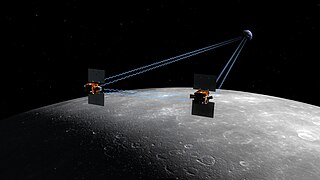
The Gravity Recovery and Interior Laboratory (GRAIL) was an American lunar science mission in NASA's Discovery Program which used high-quality gravitational field mapping of the Moon to determine its interior structure. The two small spacecraft GRAIL A (Ebb) and GRAIL B (Flow) were launched on 10 September 2011 aboard a single launch vehicle: the most-powerful configuration of a Delta II, the 7920H-10. GRAIL A separated from the rocket about nine minutes after launch, GRAIL B followed about eight minutes later. They arrived at their orbits around the Moon 25 hours apart. The first probe entered orbit on 31 December 2011 and the second followed on 1 January 2012. The two spacecraft impacted the Lunar surface on December 17, 2012.
In general relativity, Lense–Thirring precession or the Lense–Thirring effect is a relativistic correction to the precession of a gyroscope near a large rotating mass such as the Earth. It is a gravitomagnetic frame-dragging effect. It is a prediction of general relativity consisting of secular precessions of the longitude of the ascending node and the argument of pericenter of a test particle freely orbiting a central spinning mass endowed with angular momentum .
Frame-dragging is an effect on spacetime, predicted by Albert Einstein's general theory of relativity, that is due to non-static stationary distributions of mass–energy. A stationary field is one that is in a steady state, but the masses causing that field may be non-static — rotating, for instance. More generally, the subject that deals with the effects caused by mass–energy currents is known as gravitoelectromagnetism, which is analogous to the magnetism of classical electromagnetism.
In geophysics and physical geodesy, a geopotential model is the theoretical analysis of measuring and calculating the effects of Earth's gravitational field . The Earth is not exactly spherical, mainly because of its rotation around the polar axis that makes its shape slightly oblate. However, a spherical harmonics series expansion captures the actual field with increasing fidelity.
In orbital mechanics, a frozen orbit is an orbit for an artificial satellite in which perturbations have been minimized by careful selection of the orbital parameters. Perturbations can result from natural drifting due to the central body's shape, or other factors. Typically, the altitude of a satellite in a frozen orbit remains constant at the same point in each revolution over a long period of time. Variations in the inclination, position of the apsis of the orbit, and eccentricity have been minimized by choosing initial values so that their perturbations cancel out. This results in a long-term stable orbit that minimizes the use of station-keeping propellant.
In geodesy and geophysics, theoretical gravity or normal gravity is an approximation of Earth's gravity, on or near its surface, by means of a mathematical model. The most common theoretical model is a rotating Earth ellipsoid of revolution.
The Clohessy–Wiltshire equations describe a simplified model of orbital relative motion, in which the target is in a circular orbit, and the chaser spacecraft is in an elliptical or circular orbit. This model gives a first-order approximation of the chaser's motion in a target-centered coordinate system. It is used to plan the rendezvous of the chaser with the target.
In planetary sciences, the moment of inertia factor or normalized polar moment of inertia is a dimensionless quantity that characterizes the radial distribution of mass inside a planet or satellite. Since a moment of inertia has dimensions of mass times length squared, the moment of inertia factor is the coefficient that multiplies these.
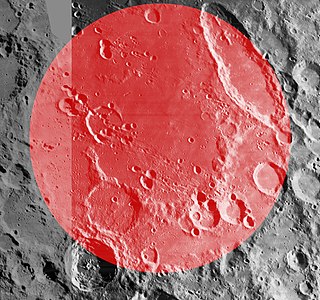
The Schiller-Zucchius Basin is a Pre-Nectarian impact basin on the near side of the Moon. It is named after the elongated crater Schiller at the northeast margin and fresh crater Zucchius near the southwest margin. This basin has received the unofficial designation 'Schiller Annular Plain' among lunar observers.

The Mendel-Ryberg Basin is a Nectarian impact basin on the southwestern limb of the moon. It is named after the crater Mendel on the west margin and the smaller crater Rydberg north of the center of the basin. The basin is due south of the larger, younger Orientale basin, and ejecta and other geomorphological effects from the younger basin have overprinted the older one.
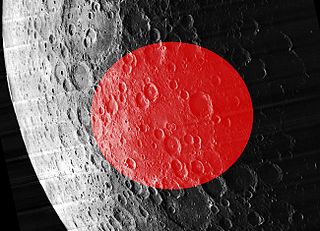
The Coulomb-Sarton Basin is a Pre-Nectarian impact basin on the far side of the Moon. It is named after the crater Coulomb northeast of the center of the basin and the smaller crater Sarton just south of the center. The basin is not obvious on the lunar surface. There are only small fragments of inner rings and a rim, and the most indicative topographic feature is a smooth, low plain at the center.

The gravity of Mars is a natural phenomenon, due to the law of gravity, or gravitation, by which all things with mass around the planet Mars are brought towards it. It is weaker than Earth's gravity due to the planet's smaller mass. The average gravitational acceleration on Mars is 3.72076 m/s2 and it varies.
